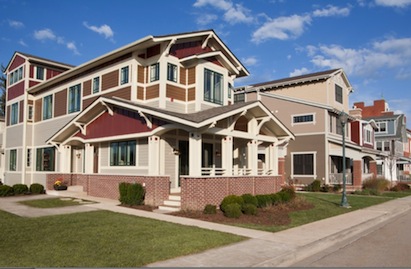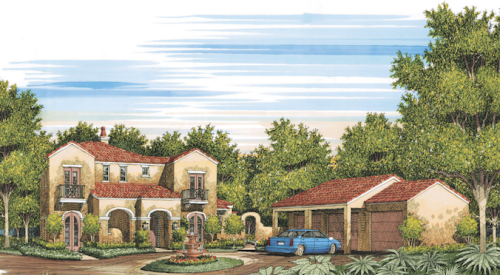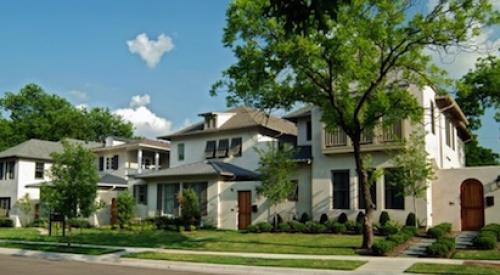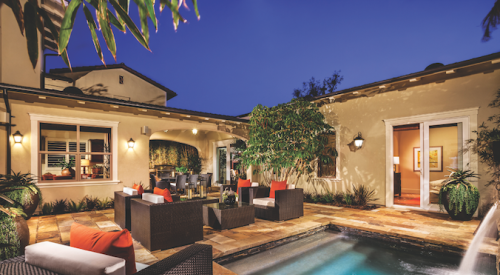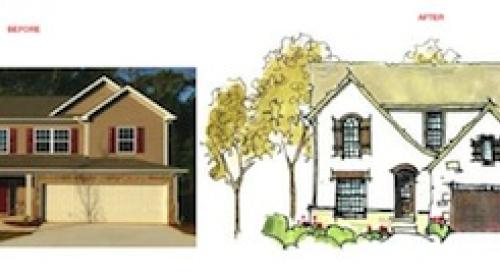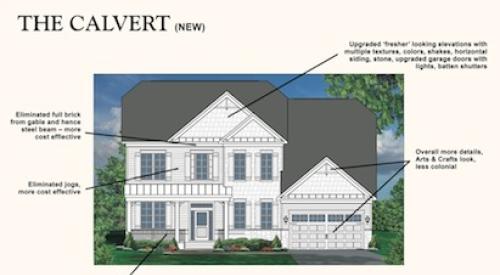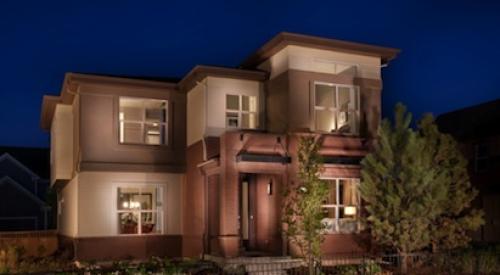The plans and photos shown here are of the Not So Big Showhouse at SchoolStreet, in Libertyville Illinois, a bungalow inspired New Urban community of 26 single family homes being built on a previously foreclosed property in Libertyville, Illinois. The land, which sits just a block away from Libertyville’s main street, was originally platted for attached townhomes.
The new developer, John McLinden of StreetScape Development, decided to keep the lot widths—just 29’ wide—but propose single family homes instead of townhouses. The city agreed, and the result is a charming street of reasonably priced and beautifully designed bungalow-inspired homes. You can learn more about the project at www.notsobigshowhouse.com.
You can read more about the energy efficiency and sustainability features of this house at: http://archive.constantcontact.com/fs092/1101567186420/archive/1109245641735.html.
And you can read more about the home’s design features here: http://archive.constantcontact.com/fs092/1101567186420/archive/1109293406196.html.
1. Sustainable in a Not So Big, and Not So Expensive Way

In the current economy there’s a new focus on green design as buyers look for ways to keep their long-term utility and maintenance costs down. One of the key tenets of Not So Big House design is that the home be right-sized to fit the real needs of the homeowners. This doesn’t mean small though. Not So Big is about creating homes that are livable, comfortable, beautiful, and functional. It’s about eliminating the seldom-used spaces so that every available dollar goes into square footage that’s in use every day. And it’s about using materials, practices and technologies that are energy efficient and sustainable, as well as cost effective.
One of the key features of the Not So Big Showhouse shown below is its sustainability, with every component selected for both effectiveness and price. The house also allows its owners to monitor and control their own consumption habits, much as hybrid vehicles today allow drivers to monitor and adjust their driving habits to reduce fuel and power consumption. This isn’t rocket science, and with today’s technologies, it doesn’t have to be expensive either. All that’s required is that we be able to see what we’re consuming and where. I firmly believe that our houses will become a lot more energy efficient when we recognize that our own monitoring of what’s happening is a key ingredient in keeping costs down.
2. Front Porches that Really Work for an Increased Sense of Community

After the tough economic times we’ve been through recently, homebuyers have come to value a sense of community and engagement with neighbors. Many people love the notion of having a comfortable front porch, where they can hang out in the evenings and on weekends and connect with friends and neighbors strolling the neighborhood, just as it was with communities of a century ago. But no matter how beautiful that porch might be, if it’s separated from the everyday living space within the house by a formal living room, dining room, or front parlor, it’s not likely to get much use—out of sight, out of mind. So to facilitate movement outside when the weather allows, the primary living space—in this case the kitchen and eating area—have been placed adjacent to the front porch.
By giving every house its own comfortably proportioned front porch accessed from primary living spaces, placing the front porch close to the street, and keeping the width of the street to a reasonable minimum so that the two sides feel like part of one thing, the opportunity for those neighborly connections rises dramatically.
Private space is also important, of course, but having the option to move out toward the street to enjoy the neighborhood and each other is an asset that’s hard to put a price on.
[PAGEBREAK]
3. Kitchen Up Front

Most American homes have their primary living spaces—the ones they use every day—focused upon their back yards, away from the street. We’re gradually coming to appreciate, however, that an over-emphasis on personal privacy can also create an unintended sense of isolation. Buyers are more open to considering the benefits of connection to the street and to neighbors, as long as there’s still plenty of private outdoor space as well. (In this house, the “back yard” is located on the garage roof—see photo in Private Outdoor Space Above Garage.) Especially when lots are narrow, and access to daylight is limited, as often happens in denser neighborhoods, the front of the house is both lighter and cheerier because of the wide-open street beyond.

In this house, the front porch is on the south side, allowing daylight to stream in all day long. By placing the kitchen and eating area adjacent to the front porch, this readily accessible outdoor space becomes a natural extension of the kitchen’s habitable area. It was interesting to listen to visitors to the house as they took in this Kitchen Up Front feature. Even the skeptical became believers as soon as they stepped inside the house. The kitchen pulled them in, and its bright informality with access to the outdoors instantly sold them on the idea. If the goal is a stronger sense of community, this is a powerful and delightful shift away from convention, and toward livability and neighborliness.

4. Double Duty Dining

One of the least used rooms in many houses is the formal dining room. Even when we have friends over for dinner, it’s often difficult to get everyone to move from the pleasant conviviality of the kitchen and into the dining room for the actual meal. What if we were to design our informal eating areas so that they can serve both formal and informal functions, and save the space (and the money) usually poured into that rarely used formal dining room?
That’s what was done in this house. The dining area adjacent to the kitchen is both beautiful and functional, with a raised countertop at the island to hide cooking prep mess from view. This allows this one dining area to serve many types of dining needs. In this way, the house can be smaller because there’s one less room, but the house actually feels bigger because you can see into every adjacent space. Nothing is separated off into rarely used separate rooms.
There are times though when we really do need a different dining arrangement—those occasions when lots of people come for dinner, such as at Thanksgiving. At such times what we really need is a much bigger room, with space for perhaps a dozen. In this house, there’s an alcove off the living room that normally serves as a library/sitting space. But when it’s time for a big dinner gathering, the furniture can be rearranged just for that day, the table brought into this area from the kitchen, and leaves added as needed—another example of doing double duty, a key strategy in getting less space to do more.
[PAGEBREAK]
5. Stairway at the Rear

Why is it that we tend to place the stairway in the front foyer, close to the main entry? The stairway looks like an invitation to explore the second floor, when in fact that’s usually the last place in the house we want our visitors to go. What about placing the stairway at the back of the house, away from the more public spaces, so that it’s clearly just for household members?
In the Not So Big Showhouse, because the lot is so narrow, the implementation of this design strategy also allowed the main living spaces to feel more connected to one another. A stairway across from the front entry would have separated the kitchen and dining areas from the main living spaces, which would likely have meant that the household would be divided between the two, and unable to communicate easily with one another.
6. Private Outdoor Space above the Garage

When a house and attached garage occupy most of the available property, as is the case throughout this community, the roof of the garage provides an excellent opportunity for an “up in the air” back yard. Because of the narrow lots, adjacent houses are close, making garden space that’s down on the ground both dark and cave-like. One storey up, though, is a different matter. Here there’s good access to both daylight and breezes.
But to make such a space work, it’s important to provide some containment at the back of the area, so that it doesn’t fall off into the alley behind. Here, a thick wall has been added to provide the needed separation from the alley. It also provides a location both for the HVAC equipment, as well as some much-needed storage for furnishings during the winter months.

7. An Away Room for Easy Aging In Place

An away room is a space that can serve multiple functions, providing a quiet place to retreat to when other members of the household are watching TV or conversing; and alternatively to contain noisy activities such as kids playing video games or the like. It is ideally located just off the main living space, with glass doors that allow for visual access, but acoustical separation.
But an away room can serve another important role by providing a future main level bedroom, should it ever be necessary for the homeowners to live on one level. In this home, in addition to its acoustical separation functions, the away room serves as a guest bedroom and in home office. There’s a full bathroom across the hall just off the mudroom, with a sliding door that hides the shower, making it feel more like a powder room on a daily basis. Should one level living become necessary though, with minor remodeling this bathroom can be made wheelchair accessible (see diagram), and the mudroom converted into bedroom closet space.
Since we can’t know ahead of time what accessibility features will be needed, the space has been designed to work for everyday needs right now, but also so that it can be modified as necessary when the time comes.
